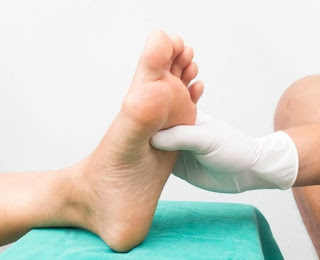HOMOEOPATHY FOR DIABETIC NEUROPATHY
Diabetic neuropathy
describes the nerve damage that is caused by the persistently raised blood
sugar found in diabetic individuals. The risk of diabetic neuropathy increases
the longer a person has diabetes and neuropathy affects up to 50% of
individuals with the condition.
Diabetic neuropathy is a
complication of diabetes that results in damage to the nervous system. It is a
progressive disease, and symptoms get worse overtime.
In some diabetics, the
onset does not cause any symptoms. Some , however may develop pain, tingling, or numbing across the
extremities such as the fingers, hands, arms, legs, and feet. These symptoms
may be mild at first and not cause concern until the condition has progressed
to a more advanced stage. However, with some types of neuropathy the onset of
pain may be sudden and severe. Nerve damage may also affect other organs such
as the heart, digestive tract and sex organs.
Causes
The persistently high
levels in the blood seen in diabetes eventually leads to narrowing of the small
blood vessels that supply nerve endings with vital nutrients and oxygen.
Without this supply of nutrients and oxygen , nerve fibers become damaged or
even disappear.
Types & Symptoms
The term neuropathy is
used to describe several types of nerve damage. In people with diabetes, there
are four main types of neuropathy.
Peripheral
diabetic neuropathy. It is the most common type of diabetic
neuropathy and causes pain and numbness in peripheries such as toes, feet and
hands.
Signs and symptoms may
include:
·
Numbness or reduced ability to feel pain or
temperature changes
·
Tingling or burning sensation
·
Sharp pains or cramps
·
Increased sensitivity to touch- for some
people even a bed sheet’s weight can be painful
·
Serious foot problems, such as ulcers,
infections, and bone and joint pain
Automatic
neuropathy. Automatic neuropathy affects systems that are
regulated by autonomic nervous system , causing changes in bowel movements,
bladder control, sexual function and blood pressure for example.
Signs and symptoms may
include:
·
A lack of awareness that blood sugar levels
are low (hypoglycemia unawareness )
·
Bladder or bowel problems
·
Slow stomach emptying ( gastroparesis),
causing nausea, vomiting and loss of appetite
·
Changes in the way the eyes adjust from
light to dark
·
Decreased sexual response
Proximal
neuropathy. This type of neuropathy often affects nerves in
the thighs, hips, buttocks, or legs. It can also affect the abdominal and chest
area. It causes pain in the thighs,
hips, or buttocks, and leads to leg weakness.
Signs and symptoms may
include:
·
Severe pain in the hip and thigh or buttock
·
Eventual weak and shrinking thigh muscles
·
Difficulty rising from a sitting position
·
Severe stomach pain
Focal
neuropathy or mono neuropathy . There are two types of focal
neuropathy-cranial and peripheral . Focal neuropathy or mononeuropathy describes damage to a specific nerve. This
type of neuropathy often comes on suddenly and usually causes pain in the face,
leg, or torso.
Signs and symptoms may
include:
·
Difficulty focusing or double vision
·
Aching behind one eye
·
Paralysis of one side of face-Bell’s palsy
·
Numbness and tingling in hands and fingers,
except little finger
·
Weakness in hand that may cause to drop
things.
HOMOEOPATHIC
REMEDIES
Homoeopathy today is a rapidly growing system and is being practiced all over the world. It strength lies in its evident effectiveness as it takes a holistic approach towards the sick individual through promotion of inner balance at mental, emotional, spiritual and physical levels. When diabetic neuropathy is concerned there are many effective medicines available in Homoeopathy , but the selection depends upon the individuality of the patient , considering mental and physical symptoms.
ARSENICUM
ALBUM: Burning pain in
hands and legs. Paralysis of lower limbs with atrophy. Tingling in fingers.
Fingers cannot be extended. Feet weak, weary and numb. Ulcers on soles and
toes. Restless feet. Wooden feeling in soles. Cramps in calves. Creeping
sensation in hands and feet with numbness.
CADMIUM
SULPH: Sensation or feeling of ants crawling in the
extremities deep in the muscles. Numbness of limbs. Crawling sensation in paralyzed
parts.
CAUSTICUM: Numbness and trembling of hands. Paralysis of
limbs. Paralytic feeling in right hand with paralysis of tongue. Unsteady
walking and easily falling. Cramps in calves, feet toes and Achilles tendon.
CONIUM
MACULATUM: Muscular weakness, especially of lower limbs. Fingers
and toes numb. Hands weary, heavy, trembling, and unsteady.
HELONIAS
DIOICA: Feet feel numb,
when sitting. Severe pain in right hip joint, worse during motion. Sore pain in
outer side of thigh. Sensation as if cool wind streamed up calves.
HYPERICUM
PERFORATUM: Crawling
in hands and feet. Sharp pain in upper and lower limbs. Tingling, numbness, and
burning.
KALI
PHOSPHORICUM:
Paralytic weakness of legs. Prickling in hands and feet. Pain with
depression and subsequent exhaustion. Numb finger tips. Paralytic lameness in back
and limbs, worse from exertion. Foot feels frost –bitten.
OXALIC
ACID: Numbness and
tingling in hands and feet. Numbness extends from shoulder to fingertips. Weak,
trembling hands and feet. Hands cold as if dead. Drawing and sharp pains shooting down limbs.
PHOSPHORIC
ACID: Great weakness
and debility of limbs. Pain at night as if bones were scraped. Formication in
limbs. Cramps in upper arms and wrists. Numbness along radial nerve. Great
sexual weakness.
PICRIC
ACID: Great weakness,
tired, heavy feeling all over the body, especially hands and legs. Acute
ascending paralysis. Pins and needle
sensation in hands and legs. Feet cold. Cannot get warm.
PLUMBUM
METALLICUM:
Paralysis of lower limbs with muscle wasting. Pain in atrophied limbs. Weakness
and painful lameness of arms and hands. Pain in muscles of thigh
come in paroxysms. Cramps in calves. Stinging, tearing, twitching, tingling,
numbness and tremor of limbs.
SULPHUR: Cold feet in day timewith burning soles at
night, wants to find a cool place for them, put them out of bed to cool them
off. Cramps in calves and soles at night.
.

.jpg)


Comments
Post a Comment